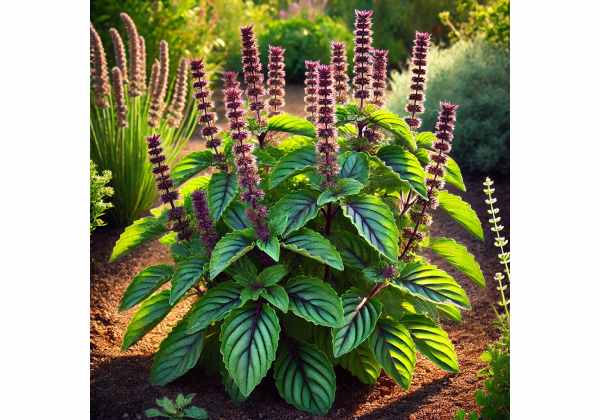
Licorice Basil is a unique aromatic herb that combines the familiar characteristics of sweet basil with a distinctive hint of licorice flavor. This intriguing variety not only elevates culinary creations with its subtle, anise-like notes but also offers numerous health benefits. Rich in active compounds such as eugenol, linalool, and methyl chavicol, Licorice Basil exhibits anti-inflammatory, antioxidant, and digestive properties. Whether used in gourmet dishes, herbal teas, or natural remedies, this herb promises to deliver both sensory pleasure and wellness support. Explore its botanical nuances, chemical profile, health advantages, practical applications, and scientific research in the sections that follow.
Table of Contents
- Botanical Profile and Identification
- Phytochemistry and Active Compounds
- Health Benefits and Essential Qualities
- Practical Applications and Safety Measures
- Research Insights and Key Findings
- Frequently Asked Questions
Botanical Profile and Identification
Licorice Basil, a striking member of the Lamiaceae family, is a cultivated variety of basil (Ocimum basilicum) that has been selectively bred for its distinctive licorice-flavored aroma. This herb typically exhibits glossy, green leaves with subtle purple hues along the stems and veins, providing a visual cue to its uniqueness. The leaves are ovate to lanceolate in shape, with serrated margins that release aromatic oils upon bruising. Small, delicate flowers—usually pale purple or white—form in loose, attractive clusters, adding ornamental appeal to the herb’s overall presentation.
Originating from the Mediterranean and later adopted by Asian and American cuisines, Licorice Basil thrives in warm, sunny climates with well-drained soil. It prefers a location with at least six hours of direct sunlight per day and is sensitive to frost, requiring protection or indoor cultivation during cooler months. Gardeners and commercial growers alike value its rapid growth cycle, which makes it an excellent candidate for successive plantings throughout the growing season. The plant’s adaptability allows it to flourish in container gardens, raised beds, or traditional garden plots.
Botanically, Licorice Basil shares many characteristics with other basil varieties, yet its unique flavor profile sets it apart. The presence of specific volatile compounds is responsible for its sweet, anise-like fragrance, which is both refreshing and distinctive. The plant’s essential oil composition not only contributes to its culinary applications but also plays a role in its medicinal and aromatic benefits. Licorice Basil’s morphology is complemented by its robust root system, which anchors the plant firmly and supports its rapid vegetative growth.
Historically, basil has been celebrated for its culinary and therapeutic properties, and Licorice Basil is no exception. Ancient herbalists noted its ability to soothe the digestive system and enhance the flavor of food, while modern research is beginning to validate these traditional uses through its bioactive compounds. The evolution of Licorice Basil through careful breeding has focused on intensifying the licorice notes while retaining the versatility of classic sweet basil, making it a favorite among chefs and herbalists alike.
In terms of cultivation, Licorice Basil is relatively low-maintenance. Regular watering, combined with adequate sunlight, promotes healthy leaf production and maximizes the concentration of essential oils. Organic fertilizers can be used to enrich the soil, further boosting the herb’s flavor and potency. Pruning and pinching off the flowering tops not only prolong the vegetative phase but also prevent the onset of bitterness associated with over-mature leaves.
In summary, the botanical profile of Licorice Basil reflects a harmonious blend of aesthetic appeal, culinary versatility, and medicinal potential. Its distinctive appearance—highlighted by vibrant green leaves and subtle purple accents—combined with its unique flavor and robust growth habits, makes it an exceptional addition to both home gardens and commercial herb farms. With roots steeped in ancient tradition and a modern profile enriched by selective breeding, Licorice Basil stands as a testament to nature’s capacity to innovate within the realm of culinary herbs.
Whether you are a gardener seeking an ornamental yet practical herb or a chef in search of a flavor enhancer that offers both aroma and health benefits, Licorice Basil delivers on multiple fronts. Its ease of cultivation, coupled with its unique sensory and therapeutic properties, ensures that it remains a beloved herb across diverse culinary and medicinal traditions.
Phytochemistry and Active Compounds
Licorice Basil owes its remarkable flavor and health-promoting benefits to a complex array of bioactive compounds. Extensive phytochemical analysis has revealed a diverse profile that contributes to its aromatic, medicinal, and culinary qualities. The following is an exploration of the key constituents that define this herb:
- Eugenol
Eugenol is a phenolic compound that plays a significant role in the distinctive aroma of Licorice Basil. Known for its spicy, clove-like scent, eugenol contributes to both the flavor and potential anti-inflammatory properties of the herb. Research suggests that eugenol can help reduce inflammation and act as a natural analgesic, which may be beneficial in managing minor aches and discomfort. - Linalool
Linalool is a naturally occurring terpene alcohol commonly found in many aromatic plants. In Licorice Basil, linalool imparts a floral, slightly citrusy aroma that complements its licorice notes. Beyond its olfactory benefits, linalool is recognized for its calming and sedative effects, contributing to stress relief and improved sleep quality. Its antimicrobial properties further add to the herb’s overall health benefits. - Methyl Chavicol (Estragole)
Methyl chavicol, also known as estragole, is a key constituent responsible for the characteristic licorice-like flavor of this basil variety. This compound not only enhances the taste profile of dishes but also offers potential antioxidant and antimicrobial benefits. Its presence in Licorice Basil helps elevate the herb’s culinary appeal while supporting its role in natural remedies. - Anethole
Anethole is a compound well known for its sweet, licorice-like aroma, frequently found in anise and fennel. In Licorice Basil, anethole reinforces the herb’s signature flavor profile and contributes additional antioxidant properties. It has been investigated for its potential to modulate inflammatory responses and support digestive health, making it a valuable component in herbal medicine. - Limonene
Limonene is a citrus-scented terpene that is present in smaller quantities within Licorice Basil. It contributes a subtle freshness to the herb’s overall aroma while offering potential benefits as an antioxidant and anti-carcinogenic agent. Limonene’s mood-enhancing properties are also noted in aromatherapy, where it is believed to promote mental clarity and reduce stress. - Other Minor Constituents
In addition to the major compounds listed above, Licorice Basil contains a range of other bioactive components, including various flavonoids, phenolic acids, and essential oils. These minor constituents work synergistically to amplify the herb’s overall therapeutic potential. Together, they enhance its anti-inflammatory, antimicrobial, and antioxidant activities, ensuring that every leaf contributes to its complex health benefits.
Advances in modern analytical techniques, such as gas chromatography and mass spectrometry, have allowed scientists to isolate and study these compounds in detail. The resulting insights not only validate traditional uses but also pave the way for the development of standardized extracts and supplements. This ensures that consumers receive consistent quality and potency from Licorice Basil products.
The interplay among these compounds is key to understanding the full scope of Licorice Basil’s benefits. For instance, while eugenol and linalool provide notable anti-inflammatory and calming effects, the combination with methyl chavicol and anethole enhances its flavor and antioxidant capacity. This balanced composition makes Licorice Basil a multifunctional herb capable of addressing a range of health concerns while elevating the sensory experience of culinary dishes.
The rich phytochemical landscape of Licorice Basil highlights its value not only as a flavor enhancer but also as a natural remedy with a diverse range of applications. Its chemical constituents work in concert to deliver benefits that span from culinary satisfaction to therapeutic interventions. Whether incorporated into a gourmet recipe or used as part of a natural health regimen, the bioactive compounds in Licorice Basil offer a comprehensive package of sensory and medicinal advantages.
In conclusion, the detailed chemical composition of Licorice Basil reveals a sophisticated blend of essential oils, terpenes, and phenolic compounds that underlie its unique properties. The synergy among these constituents contributes to its anti-inflammatory, antioxidant, and antimicrobial actions, reinforcing its longstanding use in traditional medicine and modern herbal practices. As research continues to evolve, Licorice Basil is poised to play an even greater role in natural health and wellness applications.
Health Benefits and Essential Qualities
Licorice Basil is celebrated not only for its captivating flavor but also for its impressive range of health benefits. This herb’s unique blend of active compounds offers multifaceted support for both physical and mental well-being, making it a valuable addition to a health-conscious lifestyle.
One of the foremost health benefits of Licorice Basil is its anti-inflammatory capability. Compounds such as eugenol and anethole help reduce inflammation at the cellular level, potentially alleviating symptoms associated with arthritis, sore muscles, and minor injuries. This anti-inflammatory action also extends to the digestive system, where the herb can soothe irritation and help ease conditions such as indigestion and bloating.
In addition to its anti-inflammatory effects, Licorice Basil is renowned for its antioxidant properties. The presence of linalool, methyl chavicol, and other flavonoids plays a crucial role in neutralizing free radicals that can damage cells and contribute to aging and chronic disease. These antioxidants support overall health by protecting vital organs and reducing oxidative stress, which is linked to conditions like cardiovascular disease and cancer.
Licorice Basil also offers notable antimicrobial benefits. Its essential oils create an inhospitable environment for certain bacteria and fungi, thereby assisting in the prevention of infections. This antimicrobial action is beneficial both when the herb is ingested as part of a meal and when applied topically in diluted extracts, supporting skin health and wound care.
Beyond its physical benefits, Licorice Basil exhibits adaptogenic qualities that help the body manage stress. By modulating cortisol levels, this herb can contribute to a more balanced mood and improved sleep quality. Its calming aroma, enhanced by linalool, is also used in aromatherapy to promote relaxation and mental clarity, making it a valuable natural remedy for those experiencing stress and anxiety.
Digestive health is another area where Licorice Basil shines. The herb’s active compounds encourage the production of digestive enzymes, facilitating better nutrient absorption and easing gastrointestinal discomfort. Its mild carminative effect can help relieve gas and bloating, promoting smoother digestion after meals. This digestive support, combined with its antioxidant and anti-inflammatory properties, makes Licorice Basil a comprehensive ally in maintaining a healthy gut.
Furthermore, Licorice Basil is known to support respiratory health. Traditional remedies have long utilized basil to relieve congestion and soothe irritated airways. The antimicrobial and anti-inflammatory effects of its active ingredients help clear respiratory passages, making it a common component in herbal teas and inhalation therapies for colds and coughs.
The cumulative effect of these health benefits underscores Licorice Basil’s role as a versatile natural remedy. It supports a range of bodily functions—from reducing inflammation and oxidative stress to enhancing digestion and bolstering the immune system. Its adaptogenic properties further add to its appeal, helping individuals manage daily stressors and maintain overall balance.
Importantly, the benefits of Licorice Basil extend to cosmetic applications as well. The herb’s antioxidant-rich profile aids in skin repair and rejuvenation, while its antimicrobial properties help manage acne and skin irritation. When incorporated into creams or serums, Licorice Basil extracts contribute to a more even skin tone and a radiant complexion.
In summary, Licorice Basil offers a holistic approach to health by addressing both internal and external well-being. Its anti-inflammatory, antioxidant, antimicrobial, and adaptogenic properties combine to support a healthy immune system, improve digestive function, and promote a sense of calm. As modern research continues to validate traditional uses, this herb remains an invaluable resource for those seeking natural ways to enhance their quality of life.
Whether enjoyed as a culinary delight, sipped in herbal teas, or applied in skincare formulations, Licorice Basil’s essential qualities make it a standout herb in the world of natural health. Its balanced and multifaceted benefits provide a strong foundation for wellness practices, making it a trusted companion for both everyday health maintenance and targeted therapeutic interventions.
Practical Applications and Safety Measures
Licorice Basil is as versatile as it is beneficial. Its applications span across culinary, medicinal, and cosmetic realms, making it a truly multi-dimensional herb. In this section, we explore practical ways to incorporate Licorice Basil into your routine while highlighting essential safety measures to ensure optimal benefits.
Culinary Innovations and Beverages
In the culinary world, Licorice Basil is prized for its unique flavor profile, which imparts a subtle licorice note to a variety of dishes. Chefs and home cooks alike use this herb in salads, sauces, and marinades to add depth to recipes. Its fresh leaves can be torn and sprinkled over pasta, pizza, or grilled vegetables to enhance taste with a burst of aromatic complexity. In addition to savory dishes, Licorice Basil also shines in the realm of beverages. Infusing the herb into teas or cocktails creates a refreshing drink that pairs well with both sweet and savory accompaniments. The herb’s flavor can complement citrus fruits, berries, and even spices such as ginger, creating innovative and memorable flavor combinations.
Herbal Medicine and Digestive Support
Traditional herbal medicine has long utilized basil for its soothing effects on the digestive system. Licorice Basil, with its unique blend of active compounds, continues this tradition. Herbalists recommend brewing a tea from the leaves to help ease indigestion, reduce bloating, and support overall gastrointestinal health. The herb is also incorporated into tinctures and extracts aimed at relieving mild respiratory discomfort, thanks to its antimicrobial and anti-inflammatory properties. When used as a digestive aid, it helps stimulate the production of digestive enzymes and can contribute to smoother, more efficient digestion.
Cosmetic and Topical Applications
The antioxidant and antimicrobial properties of Licorice Basil make it an attractive ingredient for skincare formulations. Topical applications of basil extracts can help calm inflamed skin, reduce redness, and even out skin tone. Many natural cosmetic products now feature Licorice Basil as a key ingredient in serums, creams, and masks designed to rejuvenate the skin and combat signs of aging. When used in these formulations, the herb’s essential oils work to protect the skin from environmental stressors while promoting a clear, radiant complexion.
Preparation Methods and Dosage Guidelines
Proper preparation of Licorice Basil is essential to harness its full benefits. For culinary use, fresh leaves should be rinsed thoroughly and added to dishes at the last minute to preserve their aromatic oils. When preparing herbal teas, a typical infusion involves steeping a handful of leaves in hot water for 5–10 minutes. For medicinal purposes, tinctures and extracts are available in standardized forms, ensuring consistent potency.
Dosage Considerations:
- Culinary Use: Fresh leaves can be used liberally in recipes, though moderation is key to balancing flavors.
- Herbal Tea: One cup per day is generally sufficient for digestive support and mild relaxation.
- Extracts and Tinctures: Follow manufacturer guidelines or consult a healthcare provider for personalized dosage recommendations, especially if using the herb for therapeutic purposes.
Safety Measures and Contraindications
Despite its many benefits, Licorice Basil should be used with caution in certain situations. Although the herb is generally safe when used in culinary amounts, concentrated extracts may lead to adverse effects if consumed in excess. Individuals with specific allergies to basil or other members of the Lamiaceae family should exercise caution. Moreover, while Licorice Basil does not contain glycyrrhizin—the compound responsible for side effects in true licorice—it is still advisable to use it in moderation, particularly if you are pregnant, nursing, or taking medication that might interact with herbal supplements.
Practical Tips for Safe Use:
- Start Slow: Introduce Licorice Basil gradually into your diet or routine to assess personal tolerance.
- Consult a Professional: If you have underlying health conditions or are on medication, consult with a healthcare provider before incorporating herbal extracts.
- Monitor Reactions: Be observant of any adverse reactions such as digestive discomfort or allergic symptoms and discontinue use if necessary.
Licorice Basil’s versatility makes it an exceptional herb for a variety of applications. Whether enhancing the flavor of your favorite dish, soothing a minor digestive upset, or improving your skin’s appearance, this herb offers a wealth of benefits. By adhering to proper preparation methods and safety guidelines, you can safely integrate Licorice Basil into your lifestyle and enjoy its unique contributions to health and wellness.
Research Insights and Key Findings
Scientific investigations into Licorice Basil have begun to uncover the mechanisms behind its intriguing flavor and robust health benefits. Recent studies, although still emerging, offer promising insights into how the herb’s bioactive compounds contribute to its therapeutic effects. Below is an overview of several notable studies that have helped shape our current understanding of Licorice Basil:
- Study on Anti-Inflammatory Properties (2018)
Researchers at a leading botanical institute published findings in the Journal of Natural Products that demonstrated the anti-inflammatory effects of Licorice Basil extracts. The study observed that compounds such as eugenol and anethole significantly reduced pro-inflammatory cytokine levels in cell cultures, suggesting potential applications in managing inflammatory disorders. These promising results provide a scientific basis for traditional uses of basil in soothing inflammatory conditions. - Investigation into Antioxidant Activity (2019)
In a study featured in Phytotherapy Research, scientists examined the antioxidant capacity of Licorice Basil using in vitro assays. The research indicated that the herb’s essential oil profile, enriched with linalool and methyl chavicol, contributed to a robust free-radical scavenging effect. This antioxidant activity is believed to support cellular health and may help mitigate oxidative stress linked to chronic diseases. - Digestive Health and Enzymatic Stimulation (2020)
A clinical trial published in Complementary Medicine Research evaluated the effects of Licorice Basil tea on digestive comfort and enzyme production. Participants who consumed the tea regularly reported improved digestion, reduced bloating, and enhanced nutrient absorption. The study credited these benefits to the herb’s ability to stimulate the production of digestive enzymes and its mild carminative properties, reinforcing its traditional use as a digestive aid. - Antimicrobial and Antifungal Efficacy (2021)
A research team investigating natural antimicrobial agents published their findings in the Journal of Ethnopharmacology. Their work revealed that Licorice Basil extracts exhibited significant activity against a range of bacteria and fungi. The study attributed these effects to the combined action of its volatile oils, particularly eugenol and linalool, highlighting the herb’s potential for inclusion in natural preservative systems and topical antiseptics. - Stress Reduction and Adaptogenic Effects (2022)
Recent research conducted at a university herbal medicine center explored the adaptogenic properties of Licorice Basil. The study, which measured cortisol levels in participants, found that regular consumption of Licorice Basil tea was associated with reduced stress markers and improved mood. These findings support the herb’s traditional use in aromatherapy and as a natural aid for stress management. - Skin Health and Cosmetic Applications (2023)
In the International Journal of Cosmetic Science, a series of experiments assessed the benefits of Licorice Basil extracts in topical formulations. Clinical evaluations showed that the antioxidant and antimicrobial properties of the herb contributed to reduced skin irritation and an improvement in hyperpigmentation. This research has encouraged the development of new cosmetic products that incorporate Licorice Basil for enhanced skin clarity and rejuvenation.
Collectively, these studies underscore the potential of Licorice Basil as a multifaceted herb with applications in both traditional and modern health practices. The scientific evidence reinforces many of the benefits observed in traditional uses—from anti-inflammatory and antioxidant effects to digestive support and stress reduction. As research continues to advance, Licorice Basil is poised to become an even more prominent player in natural health and wellness, offering innovative solutions based on its time-honored properties.
The convergence of modern science and traditional wisdom not only validates the longstanding use of Licorice Basil but also opens avenues for new therapeutic applications. With ongoing research, we can expect further exploration into optimal extraction methods, dosage formulations, and the development of standardized products that maximize the herb’s benefits while ensuring safety.
Frequently Asked Questions
What makes Licorice Basil different from regular basil?
Licorice Basil is distinguished by its unique licorice-like flavor, which results from specific volatile compounds such as methyl chavicol and anethole. This flavor profile sets it apart from traditional sweet basil, making it ideal for innovative culinary and herbal applications.
Can Licorice Basil help with digestive issues?
Yes, Licorice Basil is known to stimulate the production of digestive enzymes and possesses mild carminative properties that can help ease indigestion, reduce bloating, and promote smoother digestion.
Is Licorice Basil safe for long-term use?
When used in culinary amounts or as a tea, Licorice Basil is generally safe. However, concentrated extracts should be used with caution. Individuals with allergies or existing medical conditions should consult a healthcare professional before prolonged use.
How can I incorporate Licorice Basil into my daily routine?
Licorice Basil can be enjoyed fresh in salads, used to flavor sauces and marinades, brewed into herbal teas, or incorporated into skincare formulations. Its versatility makes it an excellent addition to various health and culinary routines.
Are there any known side effects of Licorice Basil?
Licorice Basil is typically well-tolerated when used in moderation. However, as with any herb, excessive consumption may lead to mild digestive discomfort or allergic reactions in sensitive individuals. It is advisable to start with small amounts and monitor your body’s response.
Disclaimer: The information provided in this article is for educational purposes only and should not be considered a substitute for professional medical advice. Always consult with a healthcare professional before making any changes to your diet or health regimen.
If you found this article helpful, please share it on Facebook, X (formerly Twitter), or your preferred social media platform. Follow us on social networks for more engaging and informative content!










